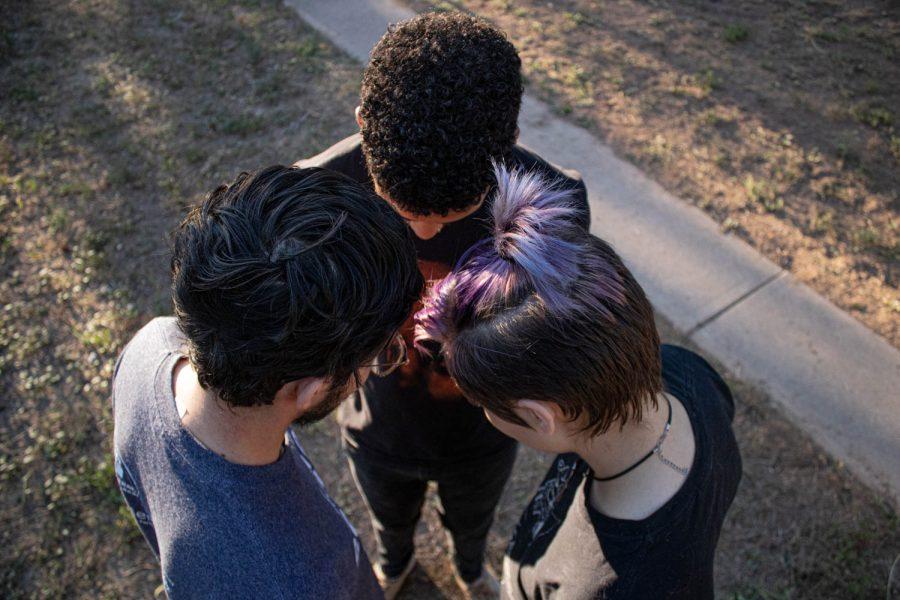Blouch: Polyamory is effective if you communicate properly
Collegian | Cat Blouch
Photo illustration of three people stand together in a triangle formation Sept. 11. The formation is a metaphor for polyamory, which is defined as engaging in multiple romantic and sometimes sexual relationships with the consent of all people involved.
September 20, 2022
Editor’s Note: All opinion section content reflects the views of the individual author only and does not represent a stance taken by The Collegian or its editorial board.
In 2022, who can really define love?
As society rapidly changes and we move toward new structures of communication, new structures surrounding relationships are created. Research has become more prevalent within the fields of gender and sexuality, and we are beginning to understand relationship structures that are outside the “traditional” one.
One of these relationship structures is polyamory. According to Chapter 16, “The Monogamous Couple, Gender Hegemony and Polyamory,” in the book “Gender Reckonings” by Mimi Schippers, “The word ‘polyamory’ means multiple loves and refers to emotionally and sometimes sexually intimate relationships with more than one person. Though we don’t have numbers on the extent of polyamory, it is estimated that people in consensually nonmonogamous relationships number in the millions.”

Polyamory might be a buzzword in the mouths of young college-aged individuals looking to explore themselves sexually, but that doesn’t mean it’s widely understood.
This brings up many of the common misunderstandings of polyamory: that it’s usually one person’s idea and the other person in the relationship is going along with it or that those in polyamorous or open relationships can’t be truly happy or fulfilled — or at least not to the extent they would be in monogamous relationships. These misconceptions simply are not true.
In fact, research suggests polyamory might provide solutions to the relationship structure that monogamy alone cannot. In the academic inquiry article “More Oxygen Please!: How Polyamorous Relationship Strategies Might Oxygenate Marriage,” authors Terri Conley and Amy Moors wrote, “We propose that people engaged in polyamory may be navigating their higher altitude needs in relationships more effectively than people in monogamous relationships.”
“You may think that with multiple people in the equation, infidelity is bound to happen, but this isn’t the case. In a polyamorous relationship, it’s all about communication.”
The paper argues that in polyamorous relationships, the individuals retain more of their autonomy due to a phenomenon in monogamous relationships wherein “as a couple progresses toward cohabitation both partners withdraw from their respective social networks.” On the contrary, polyamorous relationships offer individuals looser restrictions with their social network, which supports them to maintain their social network.

This notion was echoed by Luna Martinez in her TEDxCSU talk.
“When I was in middle school, it was one man, one woman, for a lifetime,” Martinez said. “In high school, I kept getting these confirmations of, ‘I am trying so hard to invest in … one other person, and why am I not investing that in myself or investing that in my friends or other people in general?’ It’s such a formative time.”
Polyamory encourages people to restructure their entire schema of love and relationships. Within the notion of offering more in social capital, polyamory encourages participants to seek their needs in multiple people instead of putting that responsibility on one individual.
When author Sophie Johnson spoke of her experience as a polyamorous person with New York Magazine, she said, “At some point, we got this idea that there was such a thing as ‘the one,’ and this person had to satisfy every little minutia of need, which is so unrealistic. It’s just not possible.”
You may think that with multiple people in the equation, infidelity is bound to happen, but this isn’t the case. In a polyamorous relationship, it’s all about communication.

“Infidelity can still occur in polyamorous relationships, especially when a partner violates a relational agreement,” Conley and Moors state in “More Oxygen Please!” “For example, one agreement might be that sex should not occur with a new partner without prior permission from other partner(s). Conflict could emerge if one partner then had a fling without prior approval.”
You and your partner(s) set the rules in a polyamorous relationship. This reliance on healthy communication can be a benefit for many people. Martinez echoed this in her speech, saying, “When you know your preferences, you can ask for them upfront. When you ask for them upfront, you can give yourself grace to change your mind.”
While polyamory provides an alternative to monogamy that many find beneficial in practice, it isn’t for everyone. Maybe you’ve found success and romance in a monogamous relationship, and that’s great.
Regardless, core tenets of polyamory such as respect, trust and communication can still be applied to any relationship — even those that aren’t romantic.
Reach Cat Blouch at letters@collegian.com or on Twitter @BlouchCat.






